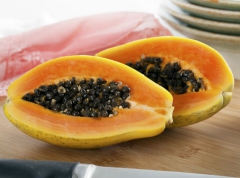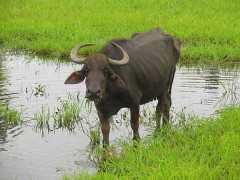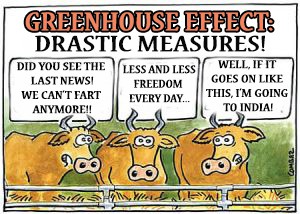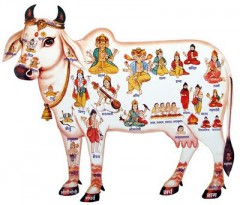11/06/2014
Pregnancy advice, Indian style
At 6 weeks, my Indian gynaecologist (a dinosaur) confirmed the pregnancy and provided her first recommendations: “You immediately stop papaya. And also pineapple. Also you stop outside food for the next 6 weeks.”
 Not that I eat papaya everyday but I don’t like being told I can’t do things! So I checked… There was only a study, conducted on rats, and here is what is says: “The results suggest that normal consumption of ripe papaya during pregnancy may not pose any significant danger. However, the unripe or semi-ripe papaya (which contains high concentration of the latex that produces marked uterine contractions) could be unsafe in pregnancy.” (source). As my new doctor puts it, you need to it kilos of papaya to maybe feel an effect, nothing to panic about after eating a slice at breakfast!
Not that I eat papaya everyday but I don’t like being told I can’t do things! So I checked… There was only a study, conducted on rats, and here is what is says: “The results suggest that normal consumption of ripe papaya during pregnancy may not pose any significant danger. However, the unripe or semi-ripe papaya (which contains high concentration of the latex that produces marked uterine contractions) could be unsafe in pregnancy.” (source). As my new doctor puts it, you need to it kilos of papaya to maybe feel an effect, nothing to panic about after eating a slice at breakfast!
 Then I informed my stock manager about the pregnancy and his first question was whether I had hanged a poster of cute babies on the wall? He was convinced of the method because he had hanged a poster of white babies and his daughter was of fair complexion! Careful not to have a Smurf pic on the wall!! When I laughed about it (in spite having seen a similar poster on my sister-in-law’s wall) I was told that having “having good looking or positive pictures on the wall can surely make me feel good which is great for overall pregnancy and well-being”. Later on, in the same vein, my favourite Indian asked me to read less thrillers and stop watching murder movies… Happy puppy will give birth to happy puppies!
Then I informed my stock manager about the pregnancy and his first question was whether I had hanged a poster of cute babies on the wall? He was convinced of the method because he had hanged a poster of white babies and his daughter was of fair complexion! Careful not to have a Smurf pic on the wall!! When I laughed about it (in spite having seen a similar poster on my sister-in-law’s wall) I was told that having “having good looking or positive pictures on the wall can surely make me feel good which is great for overall pregnancy and well-being”. Later on, in the same vein, my favourite Indian asked me to read less thrillers and stop watching murder movies… Happy puppy will give birth to happy puppies!
A few weeks later, I visited a customer and her reaction was very spontaneous: “Oh you look even more beautiful! When is your baby girl due??” Seeing my face – how could she possibly have an information (the gender) that I didn’t?? – she explained that a glow on the face indicates you will deliver a baby girl. But glowing me also has a low, small and round belly, which would indicate a boy. So let’s see!
At work, I also get “healthy” advice: “you need to eat double as you eat for two”, “don’t take the stairs it may create a shock for the baby”, “what??? You are traveling by rickshaw, stop immediately! And by bike also, are you nuts??”. No wonder a lot of pregnant Indian women turn into elephants – which is the favourite topic of my new gynaecologist: the wonder of Indian mothers’ transformation during pregnancy versus Western women – her theory is that it has to be genetic. Which I am not convinced about since studies (source) state that “women in Western Europe gain 10-12 kg in weight compared with their counterparts in the developing world [India being included in the study] where the average weight gain is 7-9 kg”. Anyhow, she still shows no compassion when I put on an extra 100 gms!
I was not given the following advice but I found it very funny: “Drinking coconut water after the seventh month of pregnancy makes the baby’s head as large as the coconut.” Or “eating something white first thing in the morning will result in a fair-skinned baby.”
And, last but not least, when discussing these Indian myth with a French friend, she shared, roaring with laughter, that she had read that in villages, pregnant women eat ghee (clarified butter (pure butterfat left over after the milk solids and water are removed from butter) commonly used in Indian cooking) to lubricate the way out of the baby. I also found it very funny till the day my favourite Indian came home with ‘my’ ghee. And no, I didn’t laugh at his face because when he came home in the first trimester with my ‘tea’ (a disgusting ayurvedic potion called ‘Bhadradi Kashayam’) he practically saved my life and helped me overcome nausea all through the pregnancy. Plus he had taken up on him to give me a healthy diet and made salads, soups, juice etc. every day. So the minimum I could do was to take him seriously and do some research. I was not supposed to eat cooking ghee but a special ‘herbal’ ghee, like he has one for his joints (depending on the herbs, the ghee will deposit in different parts of the body). And not astronomical quantities like I had been told (which was to ruin all our efforts for me not to put on too much weight). So I have been taking one spoon daily of ‘Sukhaprasava Ghritham’. It is given in 7th and 8th month of pregnancy to ensure easy delivery of child.
Sources (pregnancy myths in India): http://www.babycenter.in/x1023025/is-it-safe-to-eat-papaya-ipapitai-during-pregnancy ;
http://www.thehealthsite.com/pregnancy/eating-ghee-will-make-your-baby-slide-out-easier-and-other-such-hilarious-indian-myths-busted/; http://wonderwoman.intoday.in/story/food-myths-in-pregnancy/1/84211.html ; http://www.rediff.com/getahead/2007/may/23preg.htm
Sources (Ayurveda and pregnancy): http://www.ayurvedaelements.com/articledivinedelivery.php ; http://ayurveda-foryou.com/women/garbhasanskar.html ; http://ayurmedinfo.com/2012/05/28/sukhaprasava-ghritham-benefits-dosage-side-effects-ingredients/
08:02 Posted in Expatriation (in India and in other countries), Incredible India!, Little Samourai, My stories in India | Permalink | Comments (0) | Tags: india, pregnancy, advice, myth, papaya, ghee | ![]() Facebook | |
Facebook | |
10/04/2013
Why in India cows are sacred?
In my humble opinion, the cow is holy because, as everywhere (before industrialization), it is an animal that is super useful: it eats food waste, it provides cow-power to work in the fields, milk and dung (used as fertilizer, wall protection and combustible). And at the end of its life the cow also provides meat and leather. And two little add-ons in India: Panchagavya, a magical potion for plants and animals (including humans): it is prepared with five products from the cow (namely dung, urine, milk, curd, ghee (some fat product between oil and butter) with jaggery, banana, tender coconut and water. And Kambala, water buffalo races (see video).
Add all this to a (vague) tendency to venerate a more or less whatever comes their way and you get Indians worshipping cows! Simple...
Ah! Holy cow! Far from me the desire to stir up the debate as to whether it is good or bad to eat beef – I stopped preaching its nutritional qualities when I realized that if the billion of Indians was to eat it we may all end up suffocating in cow farts (sacred or not)!
Though it is worth highlighting that India holds the record for dairy cows (owning 15% of the 265 million animals populating the world (1)) and that, bad luck, dairy cows fart more than meaty cows (twice more exactly (2)). Pfffff as if Indians needed this additional pollution! Because, mind you, not only there are 38 million cows in India but also 100 million water buffaloes (3). And I don’t want to start thinking about buffalo farts!
Since we are at it, is a Buffalo holy or not? You need faith to worship such an ugly animal! Joke apart, you get quite a shock when you are served a buffalo milk chai (yucky for me) or when you cook your first buffalo steak (thinking you bought beef) and it gives away yellow fat. So buffalo? Sacred or not sacred?
Joke apart, you get quite a shock when you are served a buffalo milk chai (yucky for me) or when you cook your first buffalo steak (thinking you bought beef) and it gives away yellow fat. So buffalo? Sacred or not sacred?
Well it depends on the States... Sometimes the bull, bullock and buffalo are considered as cows (in addition to the cow itself, the calf and the she-buffalo); sometimes not.
Sometimes, the "sacredness" of the cow can be waived: if it exceeds a certain age or if it is no longer viable (i.e. able to produce milk or calves or to pull a plough), even if in all cases it is necessary to ask for authorisation before euthanizing a cow; sometimes not.
Sometimes (especially in Kerala, West Bengal and North-eastern States) the cow is simply not "legally" sacred and there are 3,600 legal slaughter houses (and 32,000 illegal ones which provide 70% of the meat) (4); someone has to feed all the communities of beef-eaters (Christians, Muslims and indigenous tribes, for example). And even if they are minorities, on a basis of one billion people, as much buffalo is eaten in India as beef in France every year! It is a real business. There is even a big cow-trafficking from India to the neighbouring (beef-loving) countries (5).
The Indian Constitution does not ban cow-slaughtering but protect the animal: “The State shall endeavour to organise agriculture and animal husbandry on modern and scientific lines and shall, in particular, take steps for preserving and improving the breeds, and prohibiting the slaughter, of cows and calves and other milch and draught cattle.” (Article 48)
De facto, the States have their own Prevention of Cow Slaughters Acts and the right to ban or restrict it and penalize it (6) (the killing of a cow can be punished with imprisonment (up to 7 years) and/or a fine (up to 50,000 Rs)). With as many as 28 different states and rules that change at the discretion of the governments, difficult to know where you stand!
It is indeed a verrrry sensitive topic in India and politicians don’t hesitate to use it. For instance, a story of cartridges coated with cow and pig fat almost led the Britishers to lose their colony in 1857 (7)!
Another example is the anti-cow slaughtering riots that shook India in August 1893 and caused a hundred deaths: while two festivals (Hindu and Muslim) coincided in Bombay, the press reported the sacrifice of a cow by the Muslims and things got out of control (8).
Just to say that Hindu politicians do not hesitate to invoke the holiness of the cow to agitate crowds and win votes...
Every year a water buffalo (Kambala) takes place in Kasargod (Kerala)
Next we will see why cows are free to wander in the streets in India!
(1) “India became the first world nation in milk production in 2001, ahead of the USA. In 2010, Indians produced 108 million tonnes whereas they were at 19 million 40 years earlier. Launched by the Government in 1970, the country operated a 'white revolution '. The goal: to achieve self-sufficiency to feed the population and fight poverty by providing an additional income to farmers. The number of cows is huge but the structure remains very traditional, because of religion. The cow is considered a sacred animal.” In addition, “the global production is dominated by cow milk which represents 83% of the quantities produced in 2010. Far behind, bufallo milk weighs 13%. She-buffalo milk is not common in Europe and is mainly collected in Asian countries (India, Pakistan, China).” Sources: http://www.produits-laitiers.com/Economie-et-Societe/filiere/Monde/; http://www.lemangeur-OCHA.com/Ouvrage/cultures-des-laits-du-Monde/; http://www.FAO.org/AG/againfo/programmes/FR/PPLPI/docarc/pb_wp2.html; http://www.lebulletin.com/Autres/l%E2%80%99inde-Domine-avec-38-millions-de-Vaches-30113
(2) For reasons of growth and nutrition. Source: http://www.crioc.be/files/fr/4128fr.pdf
Cow farts: the advantage of cattle is that they can feed exclusively on grass through their four stomachs and their bacteria. The downside is that this digestive specificity produces large quantities of methane, a gas contributing to the greenhouse effect and global warming. Sources: http://www.crioc.be/files/fr/4128fr.pdf; http://www.challenges.fr/Industrie/20130828.CHA3458/Le-Poisson-d-Elevage-s-EST-fait-plus-Gros-que-le-b-UF.html
(3) Buffalo:http://www.buffalopedia.cirb.res.in/index.php?option=com_content&view=article&id=60&Itemid=65&lang=en; http://en.wikipedia.org/wiki/Water_buffalo
(4) Sources: http://www.academia.edu/929980/Negotiating_the_SacredCow_Cow_Slaughter_and_the_Regulation_of_Difference_in_India;
http://drfoxvet.com/library/info/india-sacred-suffering-holy-cow
(5) 1.15 tonnes of buffalo consumed in India every year and 1.55 tonnes of beef in France.Sources: http://blogs.independent.co.uk/2012/04/30/food-fascism-the-vegetarian-hypocrisy-in-india/; http://www.planetoscope.com/elevage-viande/1587-consommation-de-viande-de-boeuf-en-france.html
Source on cow trafficking: http://www.csmonitor.com/world/global-news/2013/0126/cow-smuggling-it-s-how-Bangladesh-gets-its-beef
(6) 'The Article 48 of the Indian Constitution directs the State to take necessary steps for prohibiting the slaughter of cows and calves” Source: http://blogs.independent.co.UK/2012/04/30/food-fascism-the-vegetarian-hypocrisy-in-India/
Other sources: http://www.academia.edu/929980/Negotiating_the_SacredCow_Cow_Slaughter_and_the_Regulation_of_Difference_in_India; http://articles.timesofindia.Indiatimes.com/2012-12-16/Bangalore/35850723_1_cow-slaughter-preservation-of-cattle-Bill-cattle-Prevention-Act
(7) The protection of the cow started to gain importance in 1857, four years after new cartridges were introduced with greased paper. To open the cartridge, the sepoys (Indian soldiers of the British Army) had to tear off the paper with the teeth. A rumour started that the fat used was a mixture of pork and beef fat. And boom, both Hindu and Muslim sepoys rebelled (it was the last straw) and it took a year to put down the rebellion. And yes, the Indian independence process did not happen only through nonviolence. Sources: http://asianhistory.about.com/od/india/f/What-Was-The-Revolt-Of-1857-in-India-All-About.html; http://www.sjsu.edu/people/shantanu.phukan/courses/114/s1/Metcalf-Early%2020th%20Century%20India%20&%20Colonial%20Resistance.pdf
(8) http://paperspast.natlib.govt.nz/cgi-bin/paperspast?a=d&d=THD18931006.2.34
08:00 Posted in Why in India... | Permalink | Comments (0) | Tags: panchagavya, cow, holy cow, hinduism, dung, urine, milk, ghee, buffalo, she-buffalo, calf, bullock, dairy cow, environment, fart, slaughter, beef, meat, vegetarian, non-vegetarien, constitution, law, water buffalo, kambala, kerala, buffalo racing, cow fart, gaz, cow-trafficking | ![]() Facebook | |
Facebook | |

















